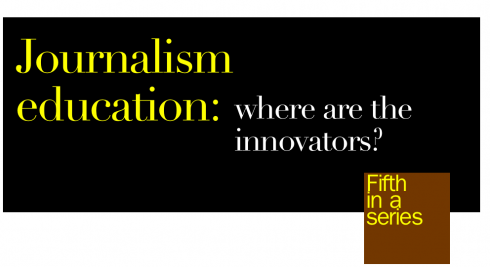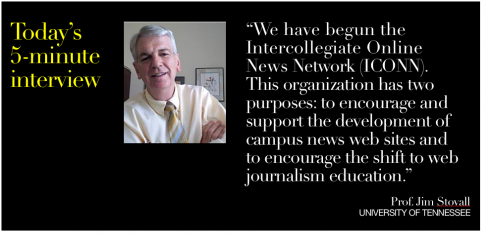–

At the University of Tennessee’s School of Journalism and Electronic Media, journalism students approach storytelling with the idea that the content comes first, then the delivery. While learning the basics of reporting and editing, students are also exposed to new courses in such topics as “the web as a news medium”. When Prof. Jim Stovall (https://www.cci.utk.edu/user/193) joined the faculty in 2006, as the Edward J. Meeman Distinguished Professor of Journalism , students came face to face with a a veteran journalist and academic who had served for 25 years at the University of Alabama , then as a visiting professor of mass communication at Emory and Henry College in Emory, Va. He was also a co-director of Southern Opinion Research , a private survey public opinion firm specializing in legal, political and media research. for more than 20 years.
Prof. Stovall has a great understanding , knowledge and respect for traditional journalism, but set his sights on taking that experience to the next level: online journalism and how to make storytelling a multi-platform event for his students.
We catch up with Prof. Stovall, busy with end of the semester tasks for this interview:
Mario: How is the University of Tennessee College of Communications and Information adapting to the rapid and challenging changes in our industry?
Prof. Stovall:
The college and the School of Journalism and Electronic Media (one of four units in the college) have recognized that the discipline and
industries of journalism are undergoing a radical change and that our curriculum and approach must change. Turning that ship is a slow
process—slower than some of us would like—but the ship is turning.
We have taken a number of steps not only to change what we do in Knoxville but also to exercise some leadership in the field of
journalism education to help other programs make the transition. Some of those steps are outlined below.
Mario: Specifically, what courses are you teaching that deal with storytelling for a multi-platform media world?
Several years ago, JEM added a couple of courses in online journalism and managing news web site that deal specifically with the web as a
news medium. These courses work well, but they are offered to a limited number of students and have the tendency to wall off web
journalism from other parts of the curriculum.
We needed a more systemic approach, and that’s what I sought when I joined the faculty here in 2006. This approach would involve changing
the entire curriculum, not just adding courses.
The first step in doing this was to create a student-operated news web site, the Tennessee Journalist (tnjn.com) that would be part of the
curriculum of the School. TNJN.com is not produced by a single course. Rather, it is operated by a staff of students as an ongoing project
and is available to any course the School offers for whatever use that course has. Our goal was to have the student staff work with
professors and instructors to figure out and meet these needs, and Ithink we are well on our way to realizing this goal.
Mario: wasn’t it difficult to create a student-operated news web site, technically speaking? What were the challenges there?
To have a web site that was a central part of the curriculum and widely available to many users, it was necessary to develop our own
content management system. We were fortunate to have people on campus at the time who could do that. Our CMS is called Ochs (after Adolph Ochs, who grew up in Knoxville), and it is built on the Django open source framework. It is designed to be very flexible and easy to learn. Our students, frankly, love it, and rookies to the system usually take less than 30 minutes to master it.
Mario: how successful was this website? And how did it help with your main mission: teaching?
TNJN.com itself has been a big hit with our students. We have a staff of about a dozen editors who are in charge of different parts of the
site. They train and supervise the students who want to join the staff as reporters, writers, photographers, video journalists and other
roles. We have a general staff meeting once a week during the semester, and there are usually at least 40 students (often more) who
show up for that. The site posts new material every day—sometimes several times a day—and it is gathering an audience. This past
semester, we averaged somewhere between 2,500 and 3,000 unique visitors a day. (Gathering an audience is good but not the point, of
course. The point is to have the web site available for our faculty
and students.)
Mario: can you tell us about areas of innovation here? How did students join the creative process?
The students themselves have done some very innovative things with the site. For instance, during this past academic year, one student got
the idea of starting an Internet radio station through TNJN. He put together several weekly call-in shows that featured sports, cars,
campus issues, and even advice to the lovelorn. TNJN Radio is now a going concern, and it’s something that I had not conceived of when we
began all of this.
Mario: what role do you play here? You are professor, mentor, adviser, among other things, right?
By coincidence, not only am I the faculty adviser to TNJN.com, but I also am the coordinator for all of our sections of our beginning news
writing course (JEM 200 Introduction to Newswriting). We have begun taking a different approach to that course, deemphasizing the industry
orientation (print, broadcasting, etc.) of the concepts we introduce and emphasizing more generic journalism concepts.
Thus, for example, what we used to refer to as “broadcast writing” we are now calling “audio journalism” and “video journalism.” We are trying to teach the students some basic concepts and practices with the course goal of having their work posted on TNJN.com. Consequently, when they enter other courses, they will already be oriented to working with the TNJN
content management system (and the instructors won’t have to teach that part) and, more importantly, they will have a basic understanding of what it means to produce journalism for a web site. (The syllabus and related materials for that course can be found at http://jprof.com/courses/jem200/jem200.html
Mario: What are the role models for you? What other colleges and universities are doing things that are worth taking a look at?
As we looked around the journalism education landscape, we found some good ideas here and there but also found that few programs were taking the comprehensive approach that we felt was necessary for us at Tennessee. With the success of TNJN.com and the Ochs content management system, we realized that other programs could benefit from our experience at UT—and from our technology.
Consequently, we decided to put Ochs into a generic form and offer it to other programs. We are in the process of doing that, and there are
a number of programs that want to use it (Georgia, Alabama, George Mason, Marist, Mass-Amherst, etc.).
Creation of the Intercollegiate Online News
Network (ICONN)
Prof. Stovall reports that the faculty at UT decided that it was time to form a network of campus news sites and journalism programs that were interested in developing along
the same lines as UT. Thus, the creation of the Intercollegiate Online News Network (ICONN). This organization has two purposes: to encourage and
support the development of campus news web sites and to encourage the shift to web journalism education.
UT hosted the founding conference for ICONN in January 2009, and more than two dozen academics and professionals joined in Knoxville to
take part.
You can find out more about ICONN at its web site:
http://intercollegiatenews.com
With these efforts, we are excited about the future of journalism and journalism education. So are our students. Two years ago, JEM had
about 350 majors and 400 or so pre-majors. This past year, those numbers grew precipitously to 450 majors and 450 pre-majors.
For more information about UT’s program:
Web sites:
JPROF
http://jprof.com
( this is the main web site that Prof. Stovall runs that
has lots of information about journalism teaching and instruction.)
JPROF, the blog
http://jprof.blogspot.com
(This is the blog where Prof. Stovall
posts articles about some of what his classes are doing)
, Additional sources:
Tennessee Journalist:
tnjn.com
ICONN
intercollegiatenews.com
Follow the Marios

Two Marios. Two Views.
Follow Mario Jr. and his blog about media analysis, web design and assorted topics related to the current state of our industry.
http://garciainteractive.com/
Visit Mario Sr. daily here, or through TweetsByDesign (www.twitter.com/tweetsbydesign)
:
To read TheRodrigoFino blog, in Spanish, go:
https://garciamedia.com/latinamerica/blog/
TheMarioBlog posting #269